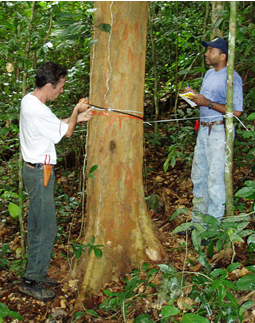Population Dynamics of Caesalpinia echintata (Brazilwood, Ibirapitanga, Pau Brasil, Pernambuco)
Introduction
Caesalpinia echinata is a tree of moist and semi-deciduous forests and is found only in the Atlantic coastal forest. It is most frequently found on growing sediments of the Tertiary "Barreiras" formation. Originally the largest populations were found near Rio de Janeiro, in southern Bahia, and in Pernambuco and adjacent states.
 Brazilwood was harvested and exported to Portugal as early as 1501 as a dyewood. By the late 1500's the annual harvest may have been as much as 12,000 tons. This may have resulted in the cutting of some two million trees during the 1500's alone. By 1605, the Portuguese crown worried that it was being over-harvested and attempted to regulate its harvest. Nevertheless, over time it became rarer and rarer. Information given here is taken from Warren Dean's "With Broadax and Firebrand: The Destruction of the Brazilian Atlantic Forest," Univ. of California Press, Berkeley, 1995.
Brazilwood was harvested and exported to Portugal as early as 1501 as a dyewood. By the late 1500's the annual harvest may have been as much as 12,000 tons. This may have resulted in the cutting of some two million trees during the 1500's alone. By 1605, the Portuguese crown worried that it was being over-harvested and attempted to regulate its harvest. Nevertheless, over time it became rarer and rarer. Information given here is taken from Warren Dean's "With Broadax and Firebrand: The Destruction of the Brazilian Atlantic Forest," Univ. of California Press, Berkeley, 1995.
While it is no longer used as a source of analine dyes, it is prized because of its rich red color and because it is the best wood for making high-quality bows for string instruments. But, because brazilwood has been selectively harvested over many centuries, and because the Atlantic coastal forest has been cleared to no more than 8% of its original extent, the remaining populations of brazilwood are few and endangered. As a result of this, the World's bow makers united and formed an association, the International Pernambuco Conservation Initiative -- IPCI, with the purpose of conserving brazilwood, the source of their raw material. The IPCI is now represented in eighteen countries (Australia, Austria, Belgium, Brazil, Canada, Denmark, England, Finland, France, Germany, Ireland, Israel, Italy, the Netherlands, New Zealand, Spain, Switzerland, the United States).
The Pau Brasil Project
One of the projects funded by the IPCI is a study of natural populations (populations found in intact forest fragments) of brazilwood in southern Bahia. Where do natural populations occur? What are natural populations like? What is the density and age structure of trees in natural populations? The Northeastern Atlantic Coastal Forest team has undertaken this study and is surveying 20 populations of brazilwood in southern Bahia.
Contact Us | ©2005 Wm. Wayt Thomas, The New York Botanical Garden
 Brazilwood was harvested and exported to Portugal as early as 1501 as a dyewood. By the late 1500's the annual harvest may have been as much as 12,000 tons. This may have resulted in the cutting of some two million trees during the 1500's alone. By 1605, the Portuguese crown worried that it was being over-harvested and attempted to regulate its harvest. Nevertheless, over time it became rarer and rarer. Information given here is taken from Warren Dean's "With Broadax and Firebrand: The Destruction of the Brazilian Atlantic Forest," Univ. of California Press, Berkeley, 1995.
Brazilwood was harvested and exported to Portugal as early as 1501 as a dyewood. By the late 1500's the annual harvest may have been as much as 12,000 tons. This may have resulted in the cutting of some two million trees during the 1500's alone. By 1605, the Portuguese crown worried that it was being over-harvested and attempted to regulate its harvest. Nevertheless, over time it became rarer and rarer. Information given here is taken from Warren Dean's "With Broadax and Firebrand: The Destruction of the Brazilian Atlantic Forest," Univ. of California Press, Berkeley, 1995.